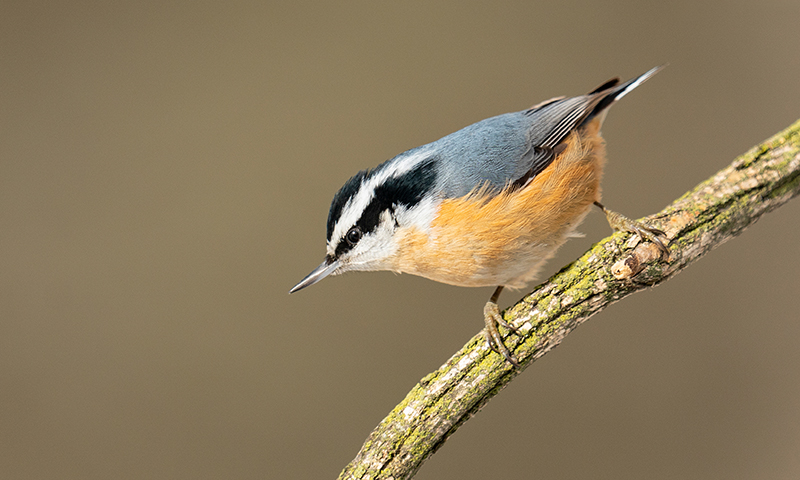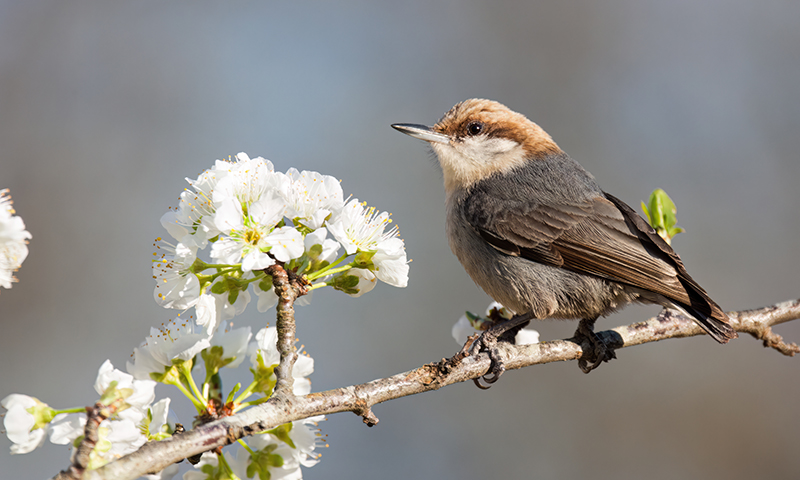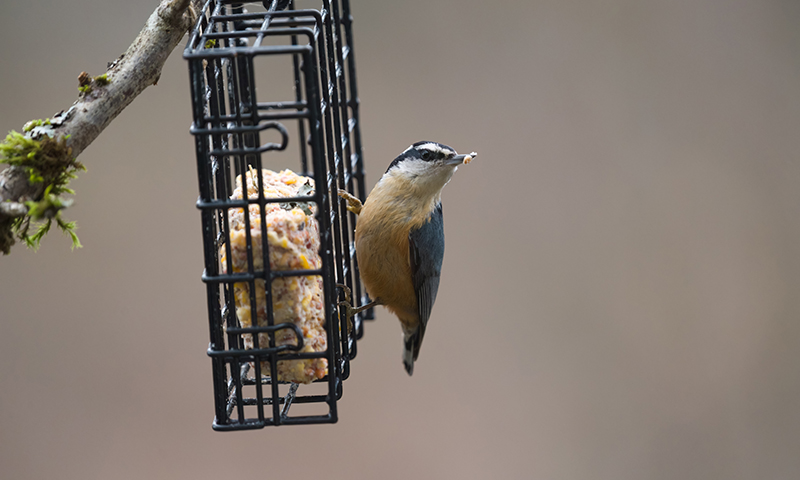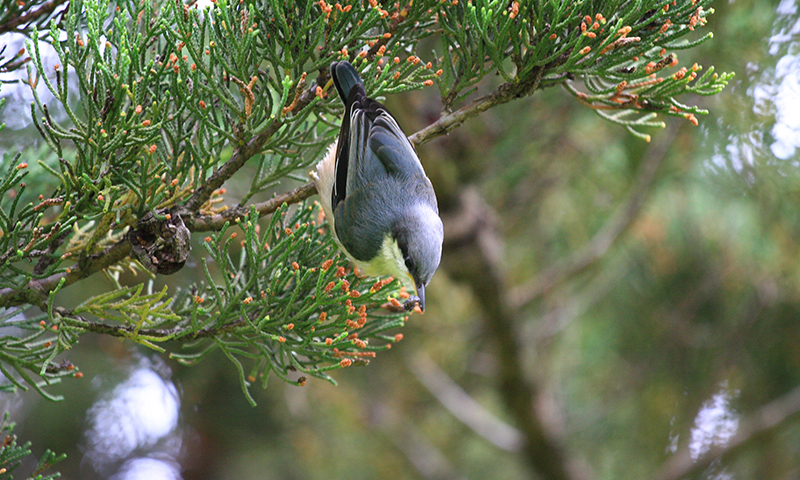All About Nuthatches and How to Attract Them
If you see a plump little bird with his head facing the ground walking down a tree trunk, it might be a nutty little nuthatch.
They do indeed enjoy being "upside down" as they explore tree bark for food or recover their hidden stash of seeds that becomes visible from the uncommon angle.
We chatted with Diana Ludwiczak, an NYC Department of Environmental Conservation licensed wildlife rehabber, to learn more about how to identify a nuthatch, where they live, and how to bring them into our yards.

Red-breasted nuthatch
How to Identify a Nuthatch
You can quickly spot a nuthatch based on its petite size (smaller than a sparrow, about 5.5 inches in length) and signature black, white, and gray feathers, Ludwiczak explained.
The gray areas (with a slight blue tinge to them) often cover the head and/or upper parts of the wings. You'll see a black eye mask-type stripe (on most varieties) with a black pointed bill extending from the black feathers. White patches sit under the eyes and down the chest on many nuthatches, or you might see a rosy reddish-brown chest adding to the colorful composition. Short legs support this round-shaped bird with a short tail.
And sometimes, nuthatches have crazy, wild feathers.
"They've been observed smearing pine and spruce pitch on their cavity holes—possibly to repel animals or mask their scent from predators," Ludwiczak explained. "They often get this pitch on their feathers, which can give them a messy look!"
Ludwiczak shared that you can see over 25 species of nuthatches in North America and Eurasia. She says the two most common species found in North America are the Red-breasted nuthatch and the White-breasted nuthatch.
The Cornell Lab All About Birds Bird Guide offers photographs and audio recordings of the Brown Creeper nuthatch, Brown-headed nuthatch, Pygmy nuthatch, Red-breasted nuthatch, and White-breasted nuthatch.
It's difficult to determine the sex of a nuthatch when birding. If you're at a banding demonstration and see several nuthatches up close, you'll discover males have darker head feathers than females.
Tip: Never heard of bird banding? It's when a trained bird bander attaches a small metal or colored band with an engraved ID number on the leg of a wild bird to learn more about its life and habits through catch and release.
Data collected often includes information about:
-
Social behaviors
-
Nesting habits
-
Territory size
-
Migration
-
Lifespan
-
Reproduction
-
Population
-
Conservation
-
And more
Some birds also get fitted with tracking devices, such as geolocators or satellite transmitters, to reduce the number of catch-and-release moments.

Brown-headed nuthatch
Where to Find Nuthatches in Nature
Birders can spot nuthatches all over the world, especially in forested areas. Nuthatches enjoy hanging out in conifer trees, which include evergreens such as pine, spruce, cedar, and fir.
Nuthatches build their homes inside existing cavities, or openings, they find in nature. These include hollowed-out broken tree limbs, tree trunks, or holes left behind by woodpeckers or insects. Pay extra close attention to these spots when looking for a nuthatch!
They will stay in forests year-round and only leave when food sources dwindle.
For example, the White-breasted nuthatch is considered a permanent resident and will only move south occasionally in what's called "unexplained irruptive movement" by Audubon.
"If there are not a lot of conifer cones, then they will migrate to a new area in search of food. Sometimes they will do this every two years or so," Ludwiczak added.

Red-breasted nuthatch perched on a cage feeder.
How to Bring Nuthatches to Your Backyard
Nuthatches dine on the seeds from conifer trees during the winter and search for small insects in the warmer months.
"Some nuthatches are known to use pine needles and twigs as tools for foraging," Ludwiczak shared. "These tools help them remove the flaky scales on tree trunks to find insects underneath!"
If you already have established conifer trees in your yard, look up the trunks during your birding adventures. You might spot a nuthatch climbing downward toward you.
"Unlike woodpeckers and most other birds that climb up trees, nuthatches descend trunks headfirst. They use their strong feet and sharp claws to grip the bark and their unusually large hind toe for balance. This unique approach lets them spot insects hiding in crevices that upward-climbers might miss," Ludwiczak explained.
If you're landscaping your property, consider the addition of conifer trees to attract nuthatches.
You can also bring nuthatches to your yard by offering a seed and/or suet-filled bird feeder. Nuthatches easily cling to suet cage feeders, will enjoy a meal, and then tuck away extra seed in tree bark to save for winter. Ludwiczak says nuthatches enjoy peanuts, mealworms, suet, and seeds.
Try a few of these high-nutrition wild bird food options in your backyard bird feeding station:
-
Kaytee Birders' Paradise: This blend of sunflower seed, safflower seed, and peanuts appeal to nuthatches and their feathered friends, including chickadees, blue jays, cardinals, woodpeckers, and titmice.
-
Kaytee Peanuts For Wild Birds: The high fat and protein content in peanuts gives wild birds extra energy in the winter months. Filling your bird feeder with peanuts will attract nuthatches, indigo buntings, woodpeckers, jays, and more!
-
Kaytee Woodpecker Cake: Bring more birds to your yard by offering a convenient seed cake (less mess!) tucked into a suet cake feeder. This blend features pine nuts, pecans, safflower seeds, sunflower seeds, peanuts, cracked corn, and more that appeal to nuthatches, chickadees, and woodpeckers.
-
Kaytee Peanut Crunch Suet Dough: During winter when food is scarce, offer this suet cake (no seed hull mess). It's made with rendered beef tallow, roasted peanuts, corn, and oats to give your wild bird friends the energy they need.

White-breasted nuthatch in its trademark "upside-down" position.
Enjoy Birding For Nuthatches
Nuthatches may not flaunt vibrant plumage like bluebirds and cardinals, but their smarts and antics keep bird watchers entertained.
"These birds are sharp-witted. They remember exactly where they've stashed food — sometimes hundreds of little caches scattered across their territory. They've even been observed weighing risk: altering how they approach feeders based on predator presence," Ludwiczak educated.
Enhance your bird-watching hobby by learning more in The Benefits of Backyard Birding and Backyard Birding Spring Checklist.
